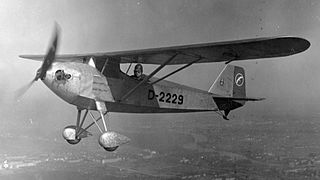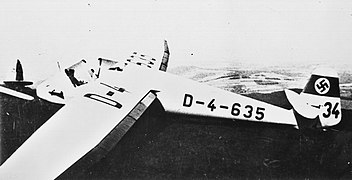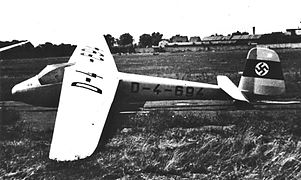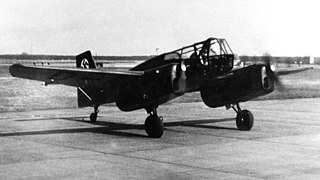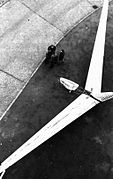Akaflieg Berlin
| Surname | Academic Aviation Group Berlin |
|---|---|
| Founded | 1920 |
| Place of foundation | Berlin-Charlottenburg |
| Association headquarters | Strasse des 17. Juni 10623 Berlin |
| Homepage | akaflieg-berlin.de |
The Akaflieg Berlin e. V. is a student association at the Technical University of Berlin , which deals with the development and construction of aircraft as well as aeronautical research.
history
Beginnings
In the spring of 1909 , the student Roland Eisenlohr founded the student group for aviation, stimulated by lectures on aviation technology at the Königlich Technische Hochschule Charlottenburg, especially by the airship designer August von Parseval . The group built a hang-glider based on Eisenlohr's design, but disbanded at the latest at the beginning of the war in 1914.
In addition to Eisenlohr as an aircraft designer, author of aviation publications and member of the Technical Commission (TeKo) of the Rhön competitions , some members of this association became known: Wsewolod Abramowitsch as chief pilot of Flugmaschine Wright GmbH, Albert Betz as head of the Aerodynamic Research Institute (AVA) in Göttingen, Heinrich Schulte- Frohlinde as director of the North German Dornier works in Wismar and Gerhard Sedlmayr as founder of the specialist house for automobiles and aviation (Autoflug).
Akaflieg 1920-1926
In 1920 the “academic working group for the promotion of aviation science through practical and theoretical activity” was established at the TH Berlin-Charlottenburg. The experimental aircraft "Charlotte" , "Teufelchen" , experimental aircraft No. 4 and two school gliders were created . It was flown in the Berlin area, u. a. at Gollenberg near Rhinow.
On August 29, 1924 - during the Rhön competition on the Wasserkuppe - Akaflieg Berlin-Charlottenburg became a founding member of the Association of Academic Aviation Groups (Idaflieg) alongside the aviation groups from Aachen , Braunschweig, Danzig , Darmstadt, Dresden, Hanover, Koethen, Munich and Stuttgart . In the middle of 1926, the club's business subsided after the first members graduated.
Akaflieg 1927-1933
At the initiative of Wilhelm Hoff , the company revived in early 1927; this time with a conscious focus on powered flight. A Heinkel HD 32 was made available by the Ministry of Transport . Later the Albatros L 68a , Messerschmitt M23b , Junkers A 50 , Arado L IIa , Udet U 12 and a Klemm L 26 with Argus engine were added. The flight took place at the Johannisthal airfield .
In 1931 the light aircraft AB4 was created for a design competition of the German Aviation Association (DLV).
Aviation Technical Group 1934–1945
In the time of National Socialism , Akaflieg existed as the "Aviation Technical Group (FFG)" at the TH Berlin at the Deutsche Versuchsanstalt für Luftfahrt e. V ”continued. After all aircraft had to be handed over to the DLV in 1933, the association received a Rhön buzzard glider and a Klemm L 25 . For flight operations, due to the heavy workload of Johannisthal during the week up to 1937, it was necessary to switch to the Bork airfield .
In 1939 he was forced to join the NSDStB .
During this period, the B5 , B6 and B8 produced some successful glider designs and the B9 as a twin-engine experimental aircraft on behalf of the RLM .
Akaflieg from 1950
In September Akaflieg was re-established at the Technical University of Berlin, and the reconstruction of existing glider types began, although after the re-approval of glider flying and the lifting of the building ban in Germany on June 21, 1951, no gliders were allowed to be built in Berlin. In the first decade a mountain falcon (D-2007 “Berliner Bär”), a Grunau-Baby III (D-2006), an L-Spatz 55 (D-2022 “Klaus Dreier”) and a take-off winch to tow these gliders were created.
Since flying was forbidden in Berlin due to the four-power status , the members of Akaflieg Berlin avoided airfields in West Germany . It was flown at the airfields Waggum (1954–1961), Großes Moor near Burgdorf (1962–1993) and, since April 1994, at its own glider airfield in Kammermark in the state of Brandenburg.
In addition to the B11 project , the construction of an SB 5 (D-2012) with a modified front part of the fuselage was added in the 1960s .
At the beginning of the 1970s, the change to fiber composite construction followed with the B12 . In parallel to the aircraft project B13 , a glider take-off winch was developed from 1984 onwards.
Akaflieg Berlin today
The association is made up of students from different fields; the majority studies aerospace engineering at the TU Berlin. The annual 200 working hours of the active members are used for the design and construction and maintenance of aircraft, the planning and evaluation of flight tests, and the maintenance of the airfield facilities in Kammermark. Most of the members stay with the association after graduation, but change their status to that of supporters. About 30 of these flies are organized in the Academic Aviation Association Berlin on the joint glider flight area Kammermark.
Berliner Akaflieg has offices and a workshop on the grounds of the TU Berlin in Charlottenburg.
In addition to repairs and modifications to the B12 and B13, an electric drive for the B13 and a retractable engine for a glider were developed, for which the association was awarded the Old Eagle sponsorship award in 2014 . Investigations into the automatic evaluation of flight performance measurements according to the photo method were also carried out.
Members
In addition to full members, Akaflieg also has a number of people who have been made honorary members for exceptional commitment:
- 1921 - August of Parseval
- 1922 - Hans Seehase
- 1922 or 1923 - Emil "Milo" Meyer-Profeld
- 1924 - Roland Eisenlohr
- 1927 - Wilhelm Hoff
- 1955 - Gerhard Fieseler
- 1957 - Willy Stiebeler
- 1960 - Horst Remm
- 1960 - Udo Augustin
- 1969 - Heinrich Hertel
- 1997 - Hans Joachim "Johnny" Wefeld
- 2017 - Achim Leutz
In-house constructions
Akaflieg Berlin's in-house aircraft developments have been designated with the prefix B for Berlin and a consecutive number since the mid-1930s . The A stood for Akaflieg on the AB4 motorized aircraft that was built in 1931 .
Gliders and gliders
- (B1) “ Charlotte ” - 1922, single-seat, brushless glider ; Construction: Hermann Winter , Edmund Pfister
- (B2) " Teufelchen " - 1923, single-seat test aircraft with wing twisting , construction: Kurt Tank
- (B3) “ Charlotte II ” - 1923, single-seat, tailless glider; Construction: Hermann Winter, Edmund Pfister, Joseph Kutin
- two school gliders
- Experimental aircraft No. 4 - 1925, single seat, side control with wing end caps
- B5 - 1937, single-seat performance glider
- B6 - 1938, single-seat performance glider with Junkers double wings
- B7 - 1939, two-seater performance glider similar to the “ Bergfalken ” developed after the Second World War , project canceled due to the priority of the B8
- B8 –1939, created after the tender for a single-seater standard glider for the 1940 Summer Olympics , two test models built
- B11 - Project started in 1961, single-seat, tailless glider, negative- swept wing
- B12 " Airlift " - 1977, two-seater tandem two-seater
Motor sailer
- B13 - 1991, two-seater two-seater, pilots sitting next to each other
Powered aircraft
- AB4 "FF" - 1931, single-seat light aircraft with folding wings, construction: Martin Schrenk , Walter Stender, Gerald Klein
- B9 - 1943, single-seat twin-engine test aircraft for a lying pilot arrangement
- B10 - 1944, two-seat, twin-engine amphibious aircraft , project canceled
"Charlotte" in August 1922 at the Rhön competition on the Wasserkuppe
"Teufelchen" in May 1923 during the coastal flight near Rossitten
B8 V2 in Johannisthal , 1938
B11 in the shell in front of the workshop in the Ernst Reuter House , 1967
B12 in Kammermark , 2015
B13 with Oehler propeller
Memberships
- German Aerospace Society
- Organization Scientifique et Technique du Vol à Voile
- Idaflieg - Association of German Academic Aviation Groups V.
Web links
literature
- Academic Fliegergruppe Berlin (Ed.): 100 Years of Akaflieg Berlin . Lukas Verlag, Berlin 2010, ISBN 978-3-86732-095-5 .
- Frank-Dieter Lemke, Rolf Jacob: The Academic Fliegergruppen in Germany until 1945 . Part 1. In: Flieger Revue extra . No. 29 , March 2010, p. 52 f .
Individual evidence
- ↑ Peter Supf: The book of German flight history . Pre-war, war, post-war. 2nd revised and expanded edition. tape 2 . Three fountains, Stuttgart 1958.
- ↑ 100 years of Akaflieg Berlin , p. 11
- ^ Hermann Winter glider flight and slow flight. Verlag Gustav Wenzel & Sohn, Braunschweig 1949, OCLC 249965646 .
- ^ Carsten Karge: Report Historical Archive . In: Akademische Fliegergruppe (Ed.): Annual Report 2013/2014 . Berlin 2015, DNB 013347667 , p. 52-54 .
- ↑ 100 years of Akaflieg Berlin , p. 23
- ↑ whisking time . In: Altherrschaft der Akademischen Fliegergruppe Berlin (Hrsg.): Chronik Akaflieg Berlin . Berlin 1977, DNB 800792807 , p. 27 .
- ^ Former owners of the Academic Aviation Group Berlin (ed.): Chronicle Akaflieg Berlin . Berlin 1977, DNB 800792807 , p. 33 .
- ^ Former owners of the Academic Aviation Group Berlin (ed.): Chronicle Akaflieg Berlin . Berlin 1977, DNB 800792807 , p. 59 f .
- ↑ a b Ullrich Kopp: Berliner Luftfahrt in Braunschweig 1952 to 1999 . In: Braunschweiger Luftfahrtgeschichte e. V. (Ed.): Braunschweigische Luftfahrtgeschichte . Appelhans Verlag, Braunschweig 2010, ISBN 978-3-941737-18-1 , p. 338 .
- ^ Former owners of the Academic Aviation Group Berlin (ed.): Chronicle Akaflieg Berlin . Berlin 1977, DNB 800792807 , p. 65 .
- ↑ About us. (No longer available online.) In: akaflieg-berlin.de. Archived from the original on October 26, 2017 ; Retrieved October 25, 2017 .
- ↑ B14 retractable engine. (No longer available online.) In: akaflieg-berlin.de. Archived from the original on August 31, 2015 ; accessed on September 16, 2015 .
- ↑ Sponsorship awards / review. In: alteadler.de. Alte Adler, accessed January 11, 2019 .
- ↑ Flight performance measurement. In: akaflieg-berlin.de. Retrieved September 16, 2015 .
- ^ Carsten Karge: Honorary Members of the Academic Aviation Group Berlin . In: Akaflieg Berlin (Ed.): Annual report 2015/2016 . June 2017, p. 86 f .
- ↑ Carsten Karge: Because training is required . In: Akaflieg Berlin (Ed.): Annual report 2015/2016 . June 2017, p. 88-90 .
Coordinates: 52 ° 31 ′ 9 ″ N , 13 ° 19 ′ 19.5 ″ E




